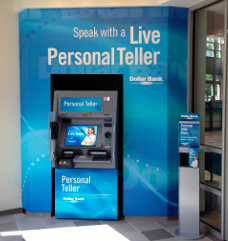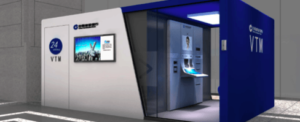 Our society has evolved beyond the 9 to 5 constraints to be a consumer driven powerhouse that likes to have what it wants, in the moment it wants it. The ATM was born to fill this very need, providing cash, in ready amounts, 24 hours a day, 7 days a week. No more would you come out of a bar at 1 am and longingly gaze at the Taco Cart, and become annoyed that you had spent all your cash. Instead, the friendly glow of the corner ATM was ready to give you what you need.
Our society has evolved beyond the 9 to 5 constraints to be a consumer driven powerhouse that likes to have what it wants, in the moment it wants it. The ATM was born to fill this very need, providing cash, in ready amounts, 24 hours a day, 7 days a week. No more would you come out of a bar at 1 am and longingly gaze at the Taco Cart, and become annoyed that you had spent all your cash. Instead, the friendly glow of the corner ATM was ready to give you what you need.
The ATM Evolution
Over the years, ATM’s have taken more than just the cash burden from financial institutions. If we look at the ATM evolution like any other system upgrade, we can consider this first phase, ATM 1.0. This was a savior of time and money, a necessary innovation that paid for itself. In fact, thanks to all those fees from non-clients, they provided a cost justification. But times evolved and ATM 2.0 emerged with the ability to handle envelope deposits, adding more convenience for clients, even if it meant higher servicing costs. The development of ATM 3.0, with its envelope free deposit imaging, freed banks from some every day costs but delivered deposits faster to the consumer. Our current evolution, ATM 4.0, introduces Video Teller. This latest advancement overcomes the hurdle of many common Teller Transactions. Both Chase and Bank of America report that by the end of the year over 60% of their deposits will be handled by their ATM fleet. It is even higher if you add in Mobile deposits, pushing the number to 75-80%. That is the lion’s share of deposit transactions.
 Banking itself has been going through its own heroic journey these past years, trying to find ways to grow organically amongst expense cutting exercises and legislative hurdles. The ATM has stepped up to help fill the void by advancing in its ability to handle transactions beyond cash dispensing. By evolving into a Video Teller, it not only dispenses cash in multiple denominations with higher daily limits, but it also cashes checks, makes deposits, provides payment processing, and all with extended hours. Currently, a Video Teller can conduct 90% of all traditional Teller Transactions; that’s enough to create a paradigm shift in how we staff and operate our branches.
Banking itself has been going through its own heroic journey these past years, trying to find ways to grow organically amongst expense cutting exercises and legislative hurdles. The ATM has stepped up to help fill the void by advancing in its ability to handle transactions beyond cash dispensing. By evolving into a Video Teller, it not only dispenses cash in multiple denominations with higher daily limits, but it also cashes checks, makes deposits, provides payment processing, and all with extended hours. Currently, a Video Teller can conduct 90% of all traditional Teller Transactions; that’s enough to create a paradigm shift in how we staff and operate our branches.
The Next Brand Billboard
The ATM has another key factor that makes it the rising star in any financial institution. It is the one thing that can replace a branch when the costs to operate in a particular area are too great. It still allows for a brand presence, a consumer touch point and, if used right, a key marketing feature. Unlike a branch, the footprint necessary for an ATM is typically relegated to a high traffic parking lot, or can share services with other small foot print merchants.
 The problem with all of this great news is that most financial institutions relegate their ATM strategy to second class status. The Branch is still king, and though, the argument isn’t necessarily to unseat the throne, it is clear that ATM’s are becoming a key piece of the economic strategy for success. While the site selection model for Branches is typically robust, the same site selection for ATM’s is lax. Brokers end up playing a bigger role than they should in their site selection due to lower capital spend. Often locations are determined by a Broker’s relationships with developers instead of a clear strategy to enhance branch awareness, consumer preferences, and location.
The problem with all of this great news is that most financial institutions relegate their ATM strategy to second class status. The Branch is still king, and though, the argument isn’t necessarily to unseat the throne, it is clear that ATM’s are becoming a key piece of the economic strategy for success. While the site selection model for Branches is typically robust, the same site selection for ATM’s is lax. Brokers end up playing a bigger role than they should in their site selection due to lower capital spend. Often locations are determined by a Broker’s relationships with developers instead of a clear strategy to enhance branch awareness, consumer preferences, and location.
Another issue is that financial institutions haven’t really concentrated on creating a quality site scoring model, and often lack the information to understand exactly how many ATMs they need in each MSA. They often use ratios like 50% of branch count as a proxy, which isn’t exactly scientific. The entirety of the market needs to be taken into consideration. Another example is Credit Unions. They make up 25% of the market and yet often they don’t make it a bank’s analytics.
Network Touch Point Strategy
Regardless, if the financial institution is a bank or a credit union, an entire touch point strategy should be developed to determine best placement of an ATM along with their branch network. With branch networks downsizing, a strong ATM strategy is even more important. Branch real estate costs aren’t going down, which is further going to drive down the square footage and increase servicing necessary outside the branch.
Looking towards the future, we can speculate how ATM 5.0 is going to further disrupt the market. The evolution  suggests that ATM and online banking will be taking over almost all account servicing and transaction volumes, leaving the staff that remains to do what they do best: help people find new products that fit their life situation.
suggests that ATM and online banking will be taking over almost all account servicing and transaction volumes, leaving the staff that remains to do what they do best: help people find new products that fit their life situation.







